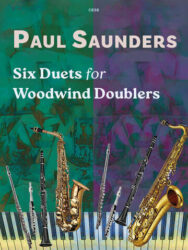“Blanco y Verde” is written in Bb for flute and clarinet, without any instrument changes. The title itself comes from Carmen Herrera, who painted several…
“Blanco y Verde” is written in Bb for flute and clarinet, without any instrument changes. The title itself comes from Carmen Herrera, who painted several large-format pictures about it in the late 1950s. They are all architecturally abstract painting styles with two colors – in this case white and green. Both colors have fascinated me for a very long time! White was Mallarmé’s color in which he put words, like Satie later did his grade points. And green – “le rayon vert” – is the color of an enigmatic installation by Marcel Duchamp for a Surrealism exhibition in Paris in 1947.
The crazy thing about the color green is how it relates to music, because we only see green when 5 photons per second enter our eyes. This is a simple quintuplet to 1 quarter = 60.
That’s why the “5” plays a special role in my piece – not just per second! And there is something else strange in this piece – the proportion 1:2 or 1:4 or 1:8. It is the octave that doubles tones in such a way that they can both merge and show independence or even independence, and can even stretch and bend the octave microtonally. As the “I interval par excellence”, “the inner upright movement”, Hermann Pfrogner verifies this enigmatic relationship before the divisions of the strings progress to the fifth and fourth.
My duo therefore contains a duality of a special kind. Every duality can become a 1, a new unity, to which a new 2 comes. Actually a free, even infinite growth structure. In it, some tones look back, as if quantumly entangled, and our perceptual organ is amazed at distances and distances that are at the same time instantaneous, without distances and distances, and still have to cope with the probability wave of the location. Quantum colors – blanco y verde?
(Nicolaus A. Huber, February 2018)





